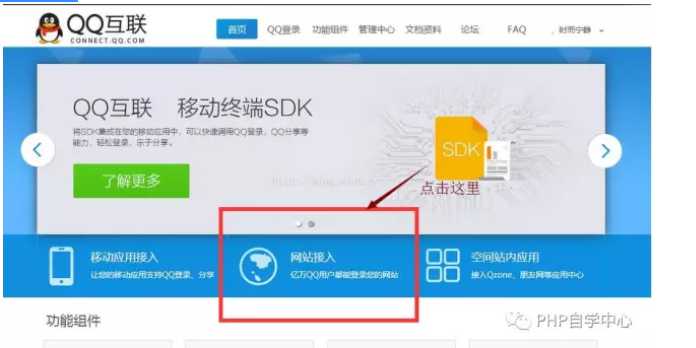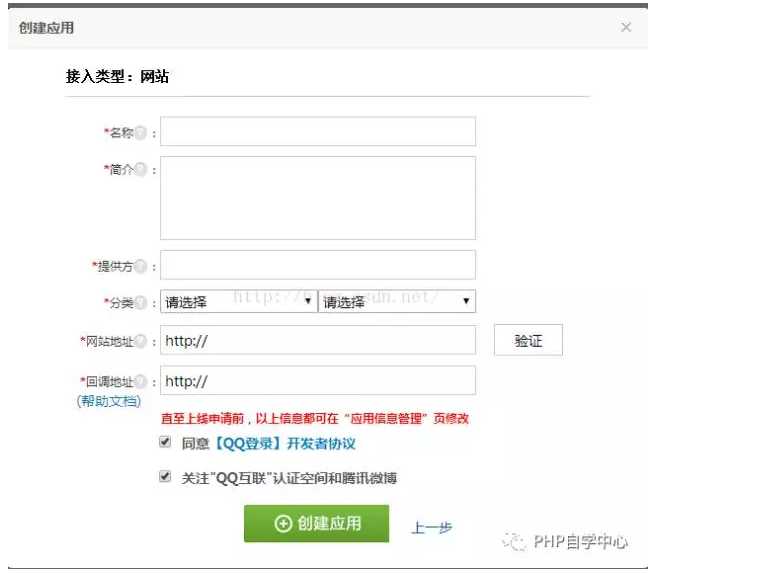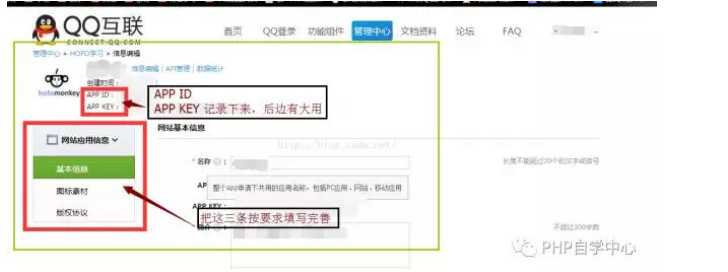PHP实现QQ快速登录,罗列了三种方法
方法一:面向过程,回调地址和首次触发登录写到了一个方法页面【因为有了if做判断】,
方法二,三:面向对象
1.先调用登录方法,向腾讯发送请求,
2.腾讯携带本网站唯一对应参数OPENID,ACCESSTOKEN,返回到对应回调页面,
3.回调页面接受到腾讯的参数后,通过这个两个参数,再发出对应的请求,如查询用户的数据。
4.腾讯做出对应的操作,如返回这个用户的数据给你
即使你没看懂,也没关系,按照我下面的流程来,保证你可以实现。
前期准备:
使用人家腾讯的功能,总得和人家打招呼吧!
QQ互联首页:http://connect.qq.com/
进入网址后,按如下操作来:
一.进入官网

二.申请创建【网站】应用

三.按要求填写资料
注意网站地址:填写你要设置快速登录的网址,eg:http://www.test.com;
回调地址:填写你发送QQ快速登陆后,腾讯得给你信息,这个信息往此页面接受。eg:http://www.test.com/accept_info.php
【详细的申请填写,请见官方提示,这里不做赘述】

四.申请成功后,完善信息

最终要求,获得APP_ID ,APP_KEY
五.代码部分:
在你对应的PHP文件内写入,如下
方法一,面向过程法
使用方法:配置$app_id,$app_secret,$my_url后,其他原封复制即可,$user_data为返回的登录信息
代码:
----------------------------------------------------------------------------------------------------------------------------------------------------------
//应用的APPID
$app_id = "你的APPID"; //应用的APPKEY $app_secret = "你的APPKEY"; //【成功授权】后的回调地址,即此地址在腾讯的信息中有储存 $my_url = "你的回调网址"; //Step1:获取Authorization Code session_start(); $code = $_REQUEST["code"];//存放Authorization Code if(empty($code)) { //state参数用于防止CSRF攻击,成功授权后回调时会原样带回 $_SESSION[‘state‘] = md5(uniqid(rand(), TRUE)); //拼接URL $dialog_url = "https://graph.qq.com/oauth2.0/authorize?response_type=code&client_id=" . $app_id . "&redirect_uri=" . urlencode($my_url) . "&state=" . $_SESSION[‘state‘]; echo("<script> top.location.href=‘" . $dialog_url . "‘</script>"); } //Step2:通过Authorization Code获取Access Token if($_REQUEST[‘state‘] == $_SESSION[‘state‘] || 1) { //拼接URL $token_url = "https://graph.qq.com/oauth2.0/token?grant_type=authorization_code&" . "client_id=" . $app_id . "&redirect_uri=" . urlencode($my_url) . "&client_secret=" . $app_secret . "&code=" . $code; $response = file_get_contents($token_url); if (strpos($response, "callback") !== false)//如果登录用户临时改变主意取消了,返回true!==false,否则执行step3 { $lpos = strpos($response, "("); $rpos = strrpos($response, ")"); $response = substr($response, $lpos + 1, $rpos - $lpos -1); $msg = json_decode($response); if (isset($msg->error)) { echo "<h3>error:</h3>" . $msg->error; echo "<h3>msg :</h3>" . $msg->error_description; exit; } } //Step3:使用Access Token来获取用户的OpenID $params = array(); parse_str($response, $params);//把传回来的数据参数变量化 $graph_url = "https://graph.qq.com/oauth2.0/me?access_token=".$params[‘access_token‘]; $str = file_get_contents($graph_url); if (strpos($str, "callback") !== false) { $lpos = strpos($str, "("); $rpos = strrpos($str, ")"); $str = substr($str, $lpos + 1, $rpos - $lpos -1); } $user = json_decode($str);//存放返回的数据 client_id ,openid if (isset($user->error)) { echo "<h3>error:</h3>" . $user->error; echo "<h3>msg :</h3>" . $user->error_description; exit; } //echo("Hello " . $user->openid); //echo("Hello " . $params[‘access_token‘]); //Step4:使用<span >openid,</span><span >access_token来获取所接受的用户信息。</span> $user_data_url = "https://graph.qq.com/user/get_user_info?access_token={$params[‘access_token‘]}&oauth_consumer_key={$app_id}&openid={$user->openid}&format=json"; $user_data = file_get_contents($user_data_url);//此为获取到的user信息 } else { echo("The state does not match. You may be a victim of CSRF."); }----------------------------------------------------------------------------------------------------------------------------------------------------------
方法二,面向对象 使用类QQ_LoginAction.class
使用方法:
1.在QQ_LoginAction.class中正确配置 APPID,APPKEY CALLBACK(回调网址)
2.在调用方法中,代码:
$qq_login = new \Component\QQ_LoginAction(); //引入此类文件即可
$qq_login->qq_login();
3.在回调页面中,代码:
$qc = new \Component\QQ_LoginAction();
$acs = $qc->qq_callback();<span style="white-space:pre"> //access_token$oid=$qc->get_openid();<span style="white-space:pre"> //openid$user_data = $qc->get_user_info();<span style="white-space:pre"> //get_user_info()为获得该用户的信息,其他操作方法见API文档4.$user_data即为返回的用户数据。
5.QQ_LoginAction.class.php 文件代码:【用的ThinkPHP3.2】
----------------------------------------------------------------------------------------------------------------------
<?php
namespace Component; session_start(); define(‘APPID‘,‘XXXX‘); //appid define(‘APPKEY‘,‘XXXX‘); //appkey define(‘CALLBACK‘,‘XXXX‘); //回调地址 define(‘SCOPE‘,‘get_user_info,list_album,add_album,upload_pic,add_topic,add_weibo‘); //授权接口列表 class QQ_LoginAction { const GET_AUTH_CODE_URL = "https://graph.qq.com/oauth2.0/authorize"; const GET_ACCESS_TOKEN_URL = "https://graph.qq.com/oauth2.0/token"; const GET_OPENID_URL = "https://graph.qq.com/oauth2.0/me"; private $APIMap = array( "get_user_info" => array( //获取用户资料 "https://graph.qq.com/user/get_user_info", array("format" => "json"), ), "add_t" => array( //发布一条普通微博 "https://graph.qq.com/t/add_t", array("format" => "json", "content","#clientip","#longitude","#latitude","#compatibleflag"), "POST" ), "add_pic_t" => array( //发布一条图片微博 "https://graph.qq.com/t/add_pic_t", array("content", "pic", "format" => "json", "#clientip", "#longitude", "#latitude", "#syncflag", "#compatiblefalg"), "POST" ), "del_t" => array( //删除一条微博 "https://graph.qq.com/t/del_t", array("id", "format" => "json"), "POST" ), "get_repost_list" => array( //获取单条微博的转发或点评列表 "https://graph.qq.com/t/get_repost_list", array("flag", "rootid", "pageflag", "pagetime", "reqnum", "twitterid", "format" => "json") ), "get_info" => array( //获取当前用户资料 "https://graph.qq.com/user/get_info", array("format" => "json") ), "get_other_info" => array( //获取其他用户资料 "https://graph.qq.com/user/get_other_info", array("format" => "json", "#name-1", "#fopenid-1") ), "get_fanslist" => array( "https://graph.qq.com/relation/get_fanslist", //我的微博粉丝列表 array("format" => "json", "reqnum", "startindex", "#mode", "#install", "#sex") ), "get_idollist" => array( "https://graph.qq.com/relation/get_idollist", //我的微博收听列表 array("format" => "json", "reqnum", "startindex", "#mode", "#install") ), "add_idol" => array( "https://graph.qq.com/relation/add_idol", //微博收听某用户 array("format" => "json", "#name-1", "#fopenids-1"), "POST" ), "del_idol" => array( //微博取消收听某用户 "https://graph.qq.com/relation/del_idol", array("format" => "json", "#name-1", "#fopenid-1"), "POST" ) ); private $keysArr; function __construct(){ if($_SESSION["openid"]){ $this->keysArr = array( "oauth_consumer_key" => APPID, "access_token" => $_SESSION[‘access_token‘], "openid" => $_SESSION["openid"] ); }else{ $this->keysArr = array( "oauth_consumer_key" => APPID ); } } public function qq_login(){ //-------生成唯一随机串防CSRF攻击 $_SESSION[‘state‘] = md5(uniqid(rand(), TRUE)); $keysArr = array( "response_type" => "code", "client_id" => APPID, "redirect_uri" => CALLBACK, "state" => $_SESSION[‘state‘], "scope" => SCOPE ); $login_url = self::GET_AUTH_CODE_URL.‘?‘.http_build_query($keysArr); header("Location:$login_url"); } public function qq_callback(){ //--------验证state防止CSRF攻击 if($_GET[‘state‘] != $_SESSION[‘state‘]){ return false; } //-------请求参数列表 $keysArr = array( "grant_type" => "authorization_code", "client_id" => APPID, "redirect_uri" => CALLBACK, "client_secret" => APPKEY, "code" => $_GET[‘code‘] ); //------构造请求access_token的url $token_url = self::GET_ACCESS_TOKEN_URL.‘?‘.http_build_query($keysArr); $response = $this->get_contents($token_url); if(strpos($response, "callback") !== false){ $lpos = strpos($response, "("); $rpos = strrpos($response, ")"); $response = substr($response, $lpos + 1, $rpos - $lpos -1); $msg = json_decode($response); if(isset($msg->error)){ $this->showError($msg->error, $msg->error_description); } } $params = array(); parse_str($response, $params); $_SESSION["access_token"]=$params["access_token"]; $this->keysArr[‘access_token‘]=$params[‘access_token‘]; return $params["access_token"]; } public function get_contents($url){ if (ini_get("allow_url_fopen") == "1") { $response = file_get_contents($url); }else{ $ch = curl_init(); curl_setopt($ch, CURLOPT_SSL_VERIFYPEER, FALSE); curl_setopt($ch, CURLOPT_RETURNTRANSFER, TRUE); curl_setopt($ch, CURLOPT_URL, $url); $response = curl_exec($ch); curl_close($ch); } if(empty($response)){ return false; } return $response; } public function get_openid(){ //-------请求参数列表 $keysArr = array( "access_token" => $_SESSION["access_token"] ); $graph_url = self::GET_OPENID_URL.‘?‘.http_build_query($keysArr); $response = $this->get_contents($graph_url); //--------检测错误是否发生 if(strpos($response, "callback") !== false){ $lpos = strpos($response, "("); $rpos = strrpos($response, ")"); $response = substr($response, $lpos + 1, $rpos - $lpos -1); } $user = json_decode($response); if(isset($user->error)){ $this->showError($user->error, $user->error_description); } //------记录openid $_SESSION[‘openid‘]=$user->openid; $this->keysArr[‘openid‘]=$user->openid; return $user->openid; } /** * showError * 显示错误信息 * @param int $code 错误代码 * @param string $description 描述信息(可选) */ public function showError($code, $description = ‘$‘){ echo "<meta charset=\"UTF-8\">"; echo "<h3>error:</h3>$code"; echo "<h3>msg :</h3>$description"; exit(); } /** * _call * 魔术方法,做api调用转发 * @param string $name 调用的方法名称 * @param array $arg 参数列表数组 * @since 5.0 * @return array 返加调用结果数组 */ public function __call($name,$arg){ //如果APIMap不存在相应的api if(empty($this->APIMap[$name])){ $this->showError("api调用名称错误","不存在的API: <span style=‘color:red;‘>$name</span>"); } //从APIMap获取api相应参数 $baseUrl = $this->APIMap[$name][0]; $argsList = $this->APIMap[$name][1]; $method = isset($this->APIMap[$name][2]) ? $this->APIMap[$name][2] : "GET"; if(empty($arg)){ $arg[0] = null; } $responseArr = json_decode($this->_applyAPI($arg[0], $argsList, $baseUrl, $method),true); //检查返回ret判断api是否成功调用 if($responseArr[‘ret‘] == 0){ return $responseArr; }else{ $this->showError($responseArr[‘ret‘], $responseArr[‘msg‘]); } } //调用相应api private function _applyAPI($arr, $argsList, $baseUrl, $method){ $pre = "#"; $keysArr = $this->keysArr; $optionArgList = array();//一些多项选填参数必选一的情形 foreach($argsList as $key => $val){ $tmpKey = $key; $tmpVal = $val; if(!is_string($key)){ $tmpKey = $val; if(strpos($val,$pre) === 0){ $tmpVal = $pre; $tmpKey = substr($tmpKey,1); if(preg_match("/-(\d$)/", $tmpKey, $res)){ $tmpKey = str_replace($res[0], "", $tmpKey); $optionArgList[]= $tmpKey; } }else{ $tmpVal = null; } } //-----如果没有设置相应的参数 if(!isset($arr[$tmpKey]) || $arr[$tmpKey] === ""){ if($tmpVal == $pre){ continue; }else if($tmpVal){//则使用默认的值 $arr[$tmpKey] = $tmpVal; }else{ $this->showError("api调用参数错误","未传入参数$tmpKey"); } } $keysArr[$tmpKey] = $arr[$tmpKey]; } //检查选填参数必填一的情形 if(count($optionArgList)!=0){ $n = 0; foreach($optionArgList as $val){ if(in_array($val, array_keys($keysArr))){ $n++; } } if(!$n){ $str = implode(",",$optionArgList); $this->showError("api调用参数错误",$str."必填一个"); } } if($method == "POST"){ $response = $this->post($baseUrl, $keysArr, 0); }else if($method == "GET"){ $baseUrl=$baseUrl.‘?‘.http_build_query($keysArr); $response = $this->get_contents($baseUrl); } return $response; } public function post($url, $keysArr, $flag = 0){ $ch = curl_init(); if(! $flag) curl_setopt($ch, CURLOPT_SSL_VERIFYPEER, FALSE); curl_setopt($ch, CURLOPT_RETURNTRANSFER, TRUE); curl_setopt($ch, CURLOPT_POST, TRUE); curl_setopt($ch, CURLOPT_POSTFIELDS, $keysArr); curl_setopt($ch, CURLOPT_URL, $url); $ret = curl_exec($ch); curl_close($ch); return $ret; } } 方法三,面向对象 使用腾讯给的SDK
使用方法:腾讯SDK,API写的很详细,不做赘述
地址:http://wiki.connect.qq.com/%E7%BD%91%E7%AB%99%E6%8E%A5%E5%85%A5%E6%A6%82%E8%BF%B0
这样就实现了QQ快捷登录,其实很简单的,大家可以试一试。
还有什么不清楚的,可以看看官方介绍,更详细,
Tips:如何在本地测试QQ快速登录
方法:修改HOST配置文件
1. 打开C:\Windows\System32\drivers\etc\host
2. 添加127.0.0.1 www.test.com
然后操作就可以了。
